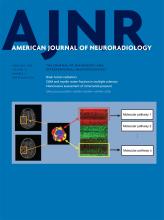Index by author
Slatter, T.L.
- Adult BrainOpen AccessMR Imaging Characteristics Associate with Tumor-Associated Macrophages in Glioblastoma and Provide an Improved Signature for Survival PrognosticationJ. Zhou, M.V. Reddy, B.K.J. Wilson, D.A. Blair, A. Taha, C.M. Frampton, R.A. Eiholzer, P.Y.C. Gan, F. Ziad, Z. Thotathil, S. Kirs, N.A. Hung, J.A. Royds and T.L. SlatterAmerican Journal of Neuroradiology February 2018, 39 (2) 252-259; DOI: https://doi.org/10.3174/ajnr.A5441
Spampinato, M.V.
- LetterYou have accessEconomic Considerations in MR Imaging of Patients with Cardiac DevicesM.U. Antonucci, M.V. Spampinato and E.R. RitenourAmerican Journal of Neuroradiology February 2018, 39 (2) E36; DOI: https://doi.org/10.3174/ajnr.A5450
Spelle, L.
- FELLOWS' JOURNAL CLUBHead and Neck ImagingYou have accessLymphographic-Like Technique for the Treatment of Microcystic Lymphatic Malformation Components of <3 mmV. Da Ros, M. Iacobucci, F. Puccinelli, L. Spelle and G. SaliouAmerican Journal of Neuroradiology February 2018, 39 (2) 350-354; DOI: https://doi.org/10.3174/ajnr.A5449
A retrospective analysis of a prospectively collected lymphatic malformation data base was performed that included 16 patients (5 males, 11 females; mean age, 15 years; range, 1=47 years). Patients with at least 1 microcystic lymphatic malformation component demonstrated on MR imaging treated by lymphographic-like technique bleomycin infusion were included in the study. Patient interviews and MR imaging were performed to assess subjective and objective clinical improvement (microcystic lymphatic malformation size decrease of >30%). The authors observed no major and 3 minor complications: 1 eyelid infection, 1 case of severe postprocedural nausea and vomiting, and 1 case of skin discoloration. MR imaging objective improvement was observed in 5/16 (31%) patients; overall improvement of clinical symptoms was obtained in 93% of treated patients. Bleomycin lymphographic-like technique for microcystic lymphatic malformations was safe and feasible with objective improvement in about one-third of patients.
Staals, J.
- Adult BrainOpen AccessOn the Reproducibility of Inversion Recovery Intravoxel Incoherent Motion Imaging in Cerebrovascular DiseaseS.M. Wong, W.H. Backes, C.E. Zhang, J. Staals, R.J. van Oostenbrugge, C.R.L.P.N. Jeukens and J.F.A. JansenAmerican Journal of Neuroradiology February 2018, 39 (2) 226-231; DOI: https://doi.org/10.3174/ajnr.A5474
States, L.J.
- Adult BrainYou have accessDiagnostic Accuracy of Amino Acid and FDG-PET in Differentiating Brain Metastasis Recurrence from Radionecrosis after Radiotherapy: A Systematic Review and Meta-AnalysisH. Li, L. Deng, H.X. Bai, J. Sun, Y. Cao, Y. Tao, L.J. States, M.D. Farwell, P. Zhang, B. Xiao and L. YangAmerican Journal of Neuroradiology February 2018, 39 (2) 280-288; DOI: https://doi.org/10.3174/ajnr.A5472
Steinman, D.A.
- NeurointerventionYou have accessBetter Than Nothing: A Rational Approach for Minimizing the Impact of Outflow Strategy on Cerebrovascular SimulationsC. Chnafa, O. Brina, V.M. Pereira and D.A. SteinmanAmerican Journal of Neuroradiology February 2018, 39 (2) 337-343; DOI: https://doi.org/10.3174/ajnr.A5484
Studler, U.
- Spine Imaging and Spine Image-Guided InterventionsYou have accessSystematic Radiation Dose Reduction in Cervical Spine CT of Human Cadaveric Specimens: How Low Can We Go?M. Tozakidou, C. Reisinger, D. Harder, J. Lieb, Z. Szucs-Farkas, M. Müller-Gerbl, U. Studler, S. Schindera and A. HirschmannAmerican Journal of Neuroradiology February 2018, 39 (2) 385-391; DOI: https://doi.org/10.3174/ajnr.A5490
Suh, S.H.
- Adult BrainYou have accessDiffusion-Weighted Imaging of Brain Metastasis from Lung Cancer: Correlation of MRI Parameters with the Histologic Type and Gene Mutation StatusW.S. Jung, C.H. Park, C.-K. Hong, S.H. Suh and S.J. AhnAmerican Journal of Neuroradiology February 2018, 39 (2) 273-279; DOI: https://doi.org/10.3174/ajnr.A5516
Sun, J.
- Adult BrainYou have accessDiagnostic Accuracy of Amino Acid and FDG-PET in Differentiating Brain Metastasis Recurrence from Radionecrosis after Radiotherapy: A Systematic Review and Meta-AnalysisH. Li, L. Deng, H.X. Bai, J. Sun, Y. Cao, Y. Tao, L.J. States, M.D. Farwell, P. Zhang, B. Xiao and L. YangAmerican Journal of Neuroradiology February 2018, 39 (2) 280-288; DOI: https://doi.org/10.3174/ajnr.A5472
Sunwoo, L.
- FELLOWS' JOURNAL CLUBNeurointerventionYou have accessFeasibility of Permanent Stenting with Solitaire FR as a Rescue Treatment for the Reperfusion of Acute Intracranial Artery OcclusionH.G. Woo, L. Sunwoo, C. Jung, B.J. Kim, M.-K. Han, H.-J. Bae, Y.J. Bae, B.S. Choi and J.H. KimAmerican Journal of Neuroradiology February 2018, 39 (2) 331-336; DOI: https://doi.org/10.3174/ajnr.A5477
From January 2011 through January 2016, among 2979 patients with acute ischemic stroke, the authors identified 27 patients who underwent permanent stent placement (13 patients with the Solitaire FR and 14 patients with other self-expanding stents). The postprocedural modified TICI grade and angiographic and clinical outcomes were assessed. Stent placement was successful in all cases. Modified TICI 2b=3 reperfusion was noted in 84.6% of the Solitaire group and in 78.6% of the other stent group. They conclude that permanent stent placement with the Solitaire FR compared with other self-expanding stents appears to be feasible and safe as a rescue tool for refractory intra-arterial therapy.








